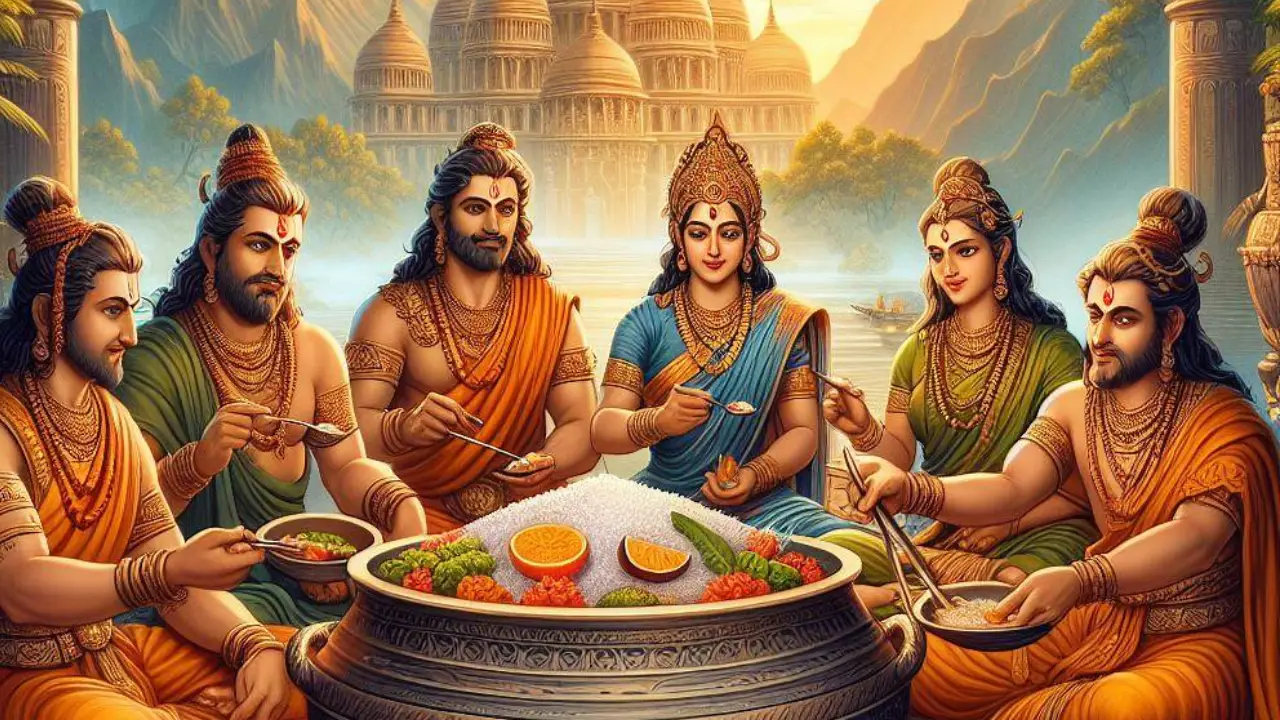In the grand tapestry of ancient epics, the Mahabharata stands as a monumental narrative capturing the essence of human virtues and vices. Within this vast chronicle, a poignant moment known as the Pandavas’ Last Meal unfolds, with Draupadi’s Rice Kettle at its heart—an emblem of resilience, unity, and resourcefulness amidst the chaos of the Kurukshetra War.
The Setting: A Feast Amidst Desolation
As the Kurukshetra War reached its climactic zenith, the Pandavas’ found themselves engulfed in desolation. The battlefield resonated with the clashing of swords, the anguished cries of warriors, and the palpable tension of impending doom. In the midst of this dire backdrop, Yudhishthira, the eldest Pandava, confronted the daunting task of organizing a last Meal.
Draupadi’s Resourcefulness Takes Center Stage
Enter Draupadi, celebrated for her resilience and resourcefulness. With a keen intellect that rivaled her unwavering spirit, she devised a plan to prepare a meal for the Pandavas’, using the limited resources at her disposal. The linchpin of this culinary endeavor was a seemingly humble rice kettle.
The Rice Kettle: A Symbol of Profound Significance
The rice kettle, an ordinary vessel elevated to symbolic prominence, encapsulated profound meanings. It became emblematic of the Pandavas’ resilience, illustrating their ability to find sustenance amidst scarcity and draw strength from unity. As Draupadi stirred the contents within, the clinking of the ladle against the kettle echoed like a hymn of hope amid the chaos of war.
Lessons Engraved in Draupadi’s Kitchen Chronicles
This historical moment imparts enduring lessons relevant to our lives. Draupadi’s resourcefulness beckons us to contemplate the power of adaptability in the face of challenges. In a world that demands quick thinking and innovative solutions, her rice kettle becomes a metaphor for making the most out of what we have, a lesson applicable to modern-day predicaments.
Draupadi’s Leadership Amidst Adversity
Draupadi’s pivotal role in orchestrating the Last Meal also serves as a beacon for leadership during crises. Instead of succumbing to despair, she took charge. She provided not just a meal but a moment of communion for the embattled Pandavas’. This underscores the idea that leadership is not solely about grand gestures but often involves small, impactful actions.
Modern Parallels: Relevance Across Time
In our contemporary lives, where challenges may not manifest on a battlefield but are no less real, the symbolism of Draupadi’s Rice Kettle resonates. It urges us to find strength in unity, face adversity with resilience, and cherish simple moments of togetherness even in the bleakest times.
Navigating Scarcity: Lessons for Today
Much like Draupadi crafting a meal from meager resources, we encounter moments of scarcity in our lives. Whether it’s a scarcity of time, resources, or opportunities, the ability to improvise and make the best of what’s available is a skill worth cultivating for a more resilient and adaptive life.
The Human Touch: A Timeless Connection
Behind the ancient tale lies a human touch that transcends time. Draupadi’s Last Meal wasn’t merely a mythological event; it was a moment reflecting the struggles and triumphs we all face. It serves as a reminder that, in the face of adversity, our shared humanity can be a source of sustenance and strength.
As we delve into the profound symbolism of Draupadi’s Rice Kettle and the Last Meal of the Pandavas’, let’s bring this discussion into the present. Share your stories of facing adversity and finding strength in unexpected places. How have you turned moments of scarcity into opportunities for growth and unity? Leave your insightful comments below, and together, let’s weave a tapestry of shared experiences.

